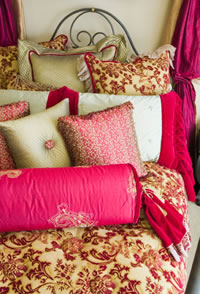A few weeks ago I sent you a few samples of stock photos our readers have taken, along with links to how those photos have been used by different photo buyers. If you missed that issue, I’ll include a link to it at the bottom of today’s note. One of these photographs was purchased by a graphic designer who creates websites and brochures for woman-owned businesses. We got in touch with this designer and asked her a few questions about the types of photos she buys and perhaps more importantly, what our readers can do to make their photos more appealing to stock photo buyers. You’ll find her answers about what photo buyers want, below… — Lori Lori Allen Director, Great Escape Publishing ************************ April 30, 2010 The Right Way to Travel ************************
What Photo Buyers Want: A Designer’s Take on Stock Photos
Interview with graphic designer April Brinkley of Lipstick and Rouge Designs
By Bonnie Caton in Portland, OR
BONNIE: April, as a graphic designer, what kinds of projects do you like to take on?
APRIL: I suppose I’m somewhat a “Jackie-of-all-trades,” as I do a little bit of everything for both print and web media. Logos, ads, brochures, postcards, and websites are among the more popular items.
While I have worked with a wide range of clients spanning numerous industries, my clients tend to be small, woman-owned businesses, generally from interior design, beauty, or fashion industries. Hence the makeup references and fun, flirty artwork on my website.
BONNIE: How often do you use stock photos in your designs?
APRIL: Quite often. Chances are, if there’s a photo in one of my designs, it’s a stock photo. I use them in just about everything for both print materials and online communiqués.
A few of my clients opt to use their own photos. But since the majority of my clients are start-up or small businesses, stock photos allow them to look polished and professional while eliminating the need for their own photographer — or at least fill in the gaps until they can expand their personal library of photos.
On a side note: There is a bit of a controversy over using stock photos on a designer or home stager’s website. However, I never misrepresent the photos as the designer or stager’s own work. The usual approach is to use stock photos on all pages except the one noted as “portfolio” or “gallery,” showcasing only the client’s actual work on this area.
BONNIE: What do you look for in a good stock photo? What makes you pick one out of a group of similar shots?
APRIL: To me, a good photo — stock or otherwise — must capture the imagination. For commercial use, stock photos need to engage the viewer and inspire them to want/be/do whatever is being “sold.” In some cases, the item for sale is an actual product. But more times than not, it’s an idea or an ideal version of that idea.
What I look for above all else when selecting stock shots is a photo that “speaks” to me, that pulls me in and makes me want to step inside.
When choosing one from a group of similar shots, my choice is partly dependent upon the logistical needs of the project: orientation, copy space, color palette, etc. Beyond that, it’s simply instinct: Which one appears to have the best overall composition?
BONNIE: When you saw Cheryl’s photo of pillows on a bed on her iStock portfolio, what made you want to buy it over the others? (See Cheryl’s photo below)

Travel Photography Resources
5 Dos and 2 Don’ts for Travel Photography
Take Great Photos And Get Paid More For Your Travel Articles
Turning a Photography Hobby into a Monthly Income
The Pros Of Selling Your Images As Stock Photography
16 Mobile Photography Tips And Tricks Every Photographer Should Know

